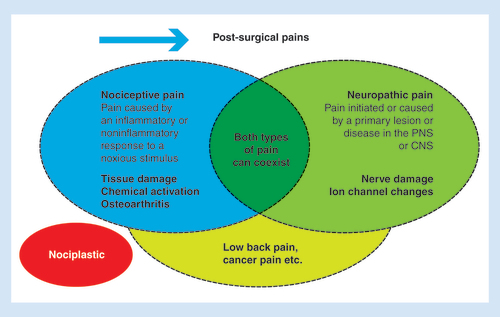Figures & data
(A) Acute nociceptive pain. (B) Inflammatory pain. (C) Neuropathic pain.
Data taken from [Citation15].
AD: Allodynia; MOR: μ-opioid receptor; HA: Hyperalgesia; HS: Hypersensitivity; STZ: Streptozotocin.
![Figure 3. Potency of tapentadol in different models of pain. (A) Acute nociceptive pain. (B) Inflammatory pain. (C) Neuropathic pain.Data taken from [Citation15].AD: Allodynia; MOR: μ-opioid receptor; HA: Hyperalgesia; HS: Hypersensitivity; STZ: Streptozotocin.](/cms/asset/287f7252-67cf-4e3d-8ba9-8039c1cc7c30/ipmt_a_12345131_f0003.jpg)
Table 1. Tests applicable in clinical practice to identify peripheral and central sensitization.
Reproduced with permission from [Citation22] © Springer Nature (2014).
NSAID: Nonsteroidal anti-inflammatory drug; OA: Osteoarthritis; PAG: Periaqueductal gray; SNRI: Serotonin-norepinephrine reuptake inhibitor.
![Figure 4. Detecting central sensitization and neuropathic features in musculoskeletal pain syndromes.Reproduced with permission from [Citation22] © Springer Nature (2014).NSAID: Nonsteroidal anti-inflammatory drug; OA: Osteoarthritis; PAG: Periaqueductal gray; SNRI: Serotonin-norepinephrine reuptake inhibitor.](/cms/asset/d55aef69-9dcc-4146-a75c-20391640c94e/ipmt_a_12345131_f0004.jpg)
†Capsaicin 8% path was (noninferior) versus pregabalin (difference: 1.2%; odds ratio: 1.03; 95% CI: 0.71–1.50).
PNI: Posttraumatic/postsurgical nerve injury.
Reproduced with permission from [Citation58], © Haanpää et al., licensed with CC BY-NC-ND 4.0.
![Figure 6. Key efficacy outcomes of the ELEVATE study. †Capsaicin 8% path was (noninferior) versus pregabalin (difference: 1.2%; odds ratio: 1.03; 95% CI: 0.71–1.50).PNI: Posttraumatic/postsurgical nerve injury.Reproduced with permission from [Citation58], © Haanpää et al., licensed with CC BY-NC-ND 4.0.](/cms/asset/e4473a38-ff92-45c3-844e-bfdcfb2575d0/ipmt_a_12345131_f0006.jpg)
Reproduced with permission from [Citation58], © Haanpää et al., licensed with CC BY-NC-ND 4.0.
CI: Confidence interval; DMA: Dynamic mechanical allodynia; EoS: End of study; LS: Least squares.
![Figure 7. Efficacy of capsaicin 8% patch and pregabalin on dynamic mechanical allodynia in the ELEVATE study.Reproduced with permission from [Citation58], © Haanpää et al., licensed with CC BY-NC-ND 4.0.CI: Confidence interval; DMA: Dynamic mechanical allodynia; EoS: End of study; LS: Least squares.](/cms/asset/282be8fa-c11c-49b0-97c1-38d387358f87/ipmt_a_12345131_f0007.jpg)



